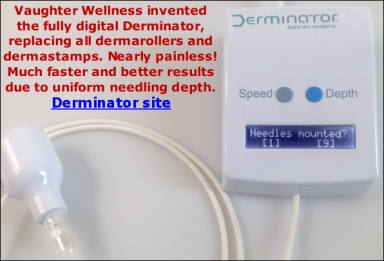>I am a new and very satisfied customer and have recommended your rollers on other forums
Thank you, I appreciate it! (especially because we do not advertise or use affiliates, so that we can keep our prices down)
The only reason I did not recommend applying Aloe vera right after dermarolling with long needles is because, depending on the percentage, Aloe vera is quite a strong anti-inflammatory.
Suppressing inflammation is very useful with chronic inflammatory conditions or "ordinary" injuries. However it is not very helpful to suppress the short lasting, mild, controlled inflammation that occurs for an hour or two right after dermarolling because the inflammation triggers collagen production and other processes. In case of dermarolling this short lasting, mild inflammation is desirable. In other cases, it is fine to use Aloe vera.
Avoiding strong- anti-inflammatory only applies right after dermarolling and I have to remove the part of my sentence "and a couple of days after". It was a mistake, I'm sorry.
An abstract on the anti-inflammatory properties of Aloe vera:
Anti-inflammatory and wound healing activity of a growth substance in Aloe vera
Davis RH, Donato JJ, Hartman GM, Haas RC.
Department of Biomedical Sciences, Pennsylvania College of Podiatric Medicine, Philadelphia.
Abstract
Aloe vera improves wound healing and inhibits inflammation. Since mannose-6-phosphate is the major sugar in the Aloe gel, the authors examined the possibility of its being an active growth substance. Mice receiving 300 mg/kg of mannose-6-phosphate had improved wound healing over saline controls. This dose also had anti-inflammatory activity. The function of mannose-6-phosphate in A. vera is discussed.
Processed Aloe vera administered topically inhibits inflammation.
Davis RH, Rosenthal KY, Cesario LR, Rouw GA
Abstract
Aloe vera preparations were evaluated for topical anti-inflammatory activity using the croton oil-induced edema assay. The results show that small amounts of A. vera given topically will inhibit inflammation induced by a moderate amount of irritant. In general, the decolorized Aloe was more effective than the colorized Aloe (with anthraquinone). A 47.1% inhibition of inflammation was obtained by 5% decolorized irradiated Aloe. These results may be used as a baseline to assess the biologic activity of A. vera in the treatment of inflammation by podiatric physicians.





